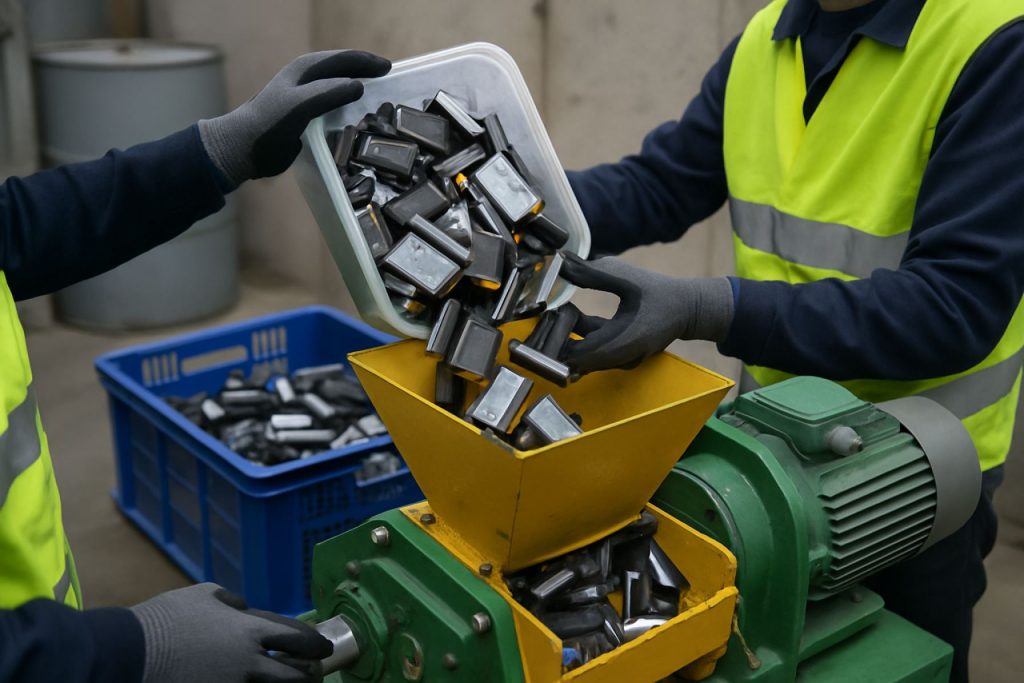
Mechanochemical Battery Recycling Industry Report 2025: In-Depth Analysis of Market Growth, Technology Advancements, and Global Opportunities. Explore Key Trends, Forecasts, and Strategic Insights for Stakeholders.
- Executive Summary & Market Overview
- Key Technology Trends in Mechanochemical Battery Recycling
- Competitive Landscape and Leading Players
- Market Growth Forecasts (2025–2030): CAGR, Volume, and Value Analysis
- Regional Market Analysis: North America, Europe, Asia-Pacific, and Rest of World
- Future Outlook: Emerging Applications and Investment Opportunities
- Challenges, Risks, and Strategic Opportunities
- Sources & References
Executive Summary & Market Overview
Mechanochemical battery recycling is an emerging technology that leverages mechanical force—such as grinding or milling—to induce chemical reactions that recover valuable metals from spent batteries. Unlike traditional pyrometallurgical or hydrometallurgical processes, mechanochemical methods operate at ambient temperatures and often require fewer hazardous chemicals, offering a more sustainable and potentially cost-effective solution for battery material recovery.
The global push for electrification, particularly in the automotive and energy storage sectors, is driving exponential growth in battery demand. According to International Energy Agency, global electric vehicle (EV) sales surpassed 14 million units in 2023, and battery demand is projected to triple by 2030. This surge is creating a parallel need for efficient recycling technologies to address both resource scarcity and environmental concerns associated with end-of-life batteries.
Mechanochemical recycling is gaining traction as a promising alternative to conventional recycling methods. Recent pilot projects and academic studies have demonstrated the process’s ability to recover critical metals such as lithium, cobalt, and nickel with high efficiency and lower energy input. For example, research published by Nature Publishing Group highlights that mechanochemical processes can achieve metal recovery rates exceeding 90% for certain battery chemistries, while also minimizing secondary waste streams.
Market activity in 2025 reflects growing investment and commercialization efforts. Companies such as Ascend Elements and RecycLiCo Battery Materials are advancing pilot-scale mechanochemical recycling facilities, aiming to scale up to commercial operations within the next two years. Strategic partnerships between battery manufacturers, recyclers, and automotive OEMs are accelerating technology validation and supply chain integration.
- Global market size for battery recycling is projected to reach $23.2 billion by 2025, with mechanochemical methods expected to capture a growing share due to regulatory support and sustainability mandates (MarketsandMarkets).
- Regulatory frameworks in the EU and North America are increasingly favoring low-emission, closed-loop recycling solutions, further incentivizing mechanochemical adoption (European Commission).
In summary, mechanochemical battery recycling is positioned at the forefront of the circular economy for batteries in 2025, offering a scalable, eco-friendly, and economically viable pathway to recover critical materials and support the global energy transition.
Key Technology Trends in Mechanochemical Battery Recycling
Mechanochemical battery recycling is rapidly emerging as a transformative approach to recovering valuable metals from spent lithium-ion batteries (LIBs) and other battery chemistries. As the global demand for electric vehicles and portable electronics accelerates, so does the urgency to develop efficient, sustainable, and cost-effective recycling methods. In 2025, several key technology trends are shaping the mechanochemical battery recycling landscape, driven by both environmental imperatives and economic opportunities.
- Advanced Mechanochemical Reactors: The development of high-energy ball mills and scalable mechanochemical reactors is enabling more efficient processing of battery waste. These systems are being optimized for throughput, energy consumption, and safety, allowing for the direct conversion of complex battery materials into reusable metal compounds without the need for high-temperature smelting or hazardous chemicals. Companies such as Umicore and research institutions are investing in pilot-scale mechanochemical plants to demonstrate commercial viability.
- Selective Recovery of Critical Metals: Recent advances in mechanochemical processes allow for the targeted extraction of high-value metals such as lithium, cobalt, and nickel. By fine-tuning milling parameters and using solid-state reagents, researchers can selectively break down cathode materials and separate metals with high purity. This trend is supported by collaborative projects between industry and academia, as highlighted in reports by the International Energy Agency (IEA).
- Integration with Green Chemistry: Mechanochemical recycling is increasingly being paired with green chemistry principles, minimizing the use of solvents and reducing secondary waste streams. Innovations include the use of benign solid reactants and the elimination of water-intensive leaching steps, aligning with stricter environmental regulations in regions such as the EU and China (European Commission).
- Digitalization and Process Monitoring: The adoption of real-time monitoring technologies, such as in situ spectroscopy and machine learning-driven process control, is enhancing the efficiency and reproducibility of mechanochemical recycling. These digital tools enable rapid optimization of process parameters and quality assurance, as reported by IDTechEx.
- Commercialization and Scale-Up: 2025 is witnessing a shift from laboratory-scale demonstrations to commercial pilot projects. Strategic partnerships between battery manufacturers, recyclers, and technology providers are accelerating the deployment of mechanochemical recycling at industrial scale, as seen in initiatives led by Battery Europe.
These technology trends are positioning mechanochemical battery recycling as a cornerstone of the circular battery economy, offering a pathway to sustainable resource recovery and reduced environmental impact.
Competitive Landscape and Leading Players
The competitive landscape of the mechanochemical battery recycling market in 2025 is characterized by a mix of established recycling firms, innovative startups, and research-driven collaborations. Mechanochemical processes, which use mechanical force to drive chemical reactions for extracting valuable metals from spent batteries, are gaining traction due to their lower energy requirements and reduced environmental impact compared to traditional pyrometallurgical and hydrometallurgical methods.
Key players in this space are leveraging proprietary mechanochemical technologies to differentiate themselves. Umicore, a global leader in materials technology and recycling, has invested in mechanochemical research to complement its existing battery recycling operations. The company’s focus is on scaling up pilot projects and integrating mechanochemical steps to improve metal recovery rates and process sustainability.
Startups such as ACE Green Recycling are also making significant strides. ACE Green Recycling has developed a mechanochemical process for lithium-ion battery recycling that operates at room temperature, eliminating the need for high-temperature furnaces and toxic reagents. Their approach has attracted partnerships with battery manufacturers and automotive OEMs seeking greener supply chains.
Academic and public-private partnerships are another driving force. For example, the National Renewable Energy Laboratory (NREL) in the United States is collaborating with industry players to commercialize mechanochemical recycling methods, focusing on scalability and cost-effectiveness. Similarly, the Fraunhofer Society in Germany is working with European battery manufacturers to pilot mechanochemical extraction of lithium, cobalt, and nickel from end-of-life batteries.
Asian companies are also entering the field, with GEM Co., Ltd. in China exploring mechanochemical techniques to supplement its large-scale battery recycling operations. These efforts are supported by government policies promoting circular economy practices and critical material self-sufficiency.
Overall, the competitive landscape in 2025 is dynamic, with leading players focusing on technology optimization, strategic partnerships, and vertical integration. The race to commercialize efficient mechanochemical recycling processes is intensifying, driven by the surging demand for battery materials and tightening environmental regulations worldwide.
Market Growth Forecasts (2025–2030): CAGR, Volume, and Value Analysis
The mechanochemical battery recycling market is poised for robust growth between 2025 and 2030, driven by increasing global demand for sustainable battery disposal solutions and the rapid expansion of electric vehicle (EV) adoption. According to projections by IDTechEx, the global mechanochemical battery recycling market is expected to achieve a compound annual growth rate (CAGR) of approximately 18% during this period. This growth is underpinned by the technology’s ability to efficiently recover valuable metals such as lithium, cobalt, and nickel from spent batteries, while minimizing environmental impact compared to traditional pyrometallurgical and hydrometallurgical methods.
In terms of market value, the sector is projected to expand from an estimated USD 250 million in 2025 to over USD 570 million by 2030. This surge is attributed to both regulatory pressures—such as the European Union’s Battery Regulation mandating higher recycling efficiencies—and the increasing volume of end-of-life lithium-ion batteries entering the waste stream. International Energy Agency (IEA) data indicates that global EV stock will surpass 200 million units by 2030, significantly boosting the volume of batteries requiring recycling.
- Volume Analysis: The total volume of batteries processed via mechanochemical recycling is forecast to grow from approximately 40,000 metric tons in 2025 to over 120,000 metric tons by 2030, reflecting both the scaling of commercial facilities and the maturation of the technology.
- Regional Growth: Asia-Pacific is expected to lead the market, with China and South Korea investing heavily in mechanochemical recycling infrastructure. Europe follows closely, driven by stringent regulatory frameworks and the presence of major battery manufacturers.
- Technology Adoption: The adoption rate of mechanochemical processes is anticipated to accelerate as industry players seek cost-effective, low-emission alternatives to conventional recycling. Partnerships between battery producers and recycling technology firms are expected to further catalyze market expansion.
Overall, the mechanochemical battery recycling market’s growth trajectory from 2025 to 2030 will be shaped by technological advancements, regulatory developments, and the escalating need for circular economy solutions in the battery value chain. As the market matures, increased investment and innovation are likely to drive down costs and improve recovery rates, further solidifying mechanochemical recycling’s role in the global battery ecosystem.
Regional Market Analysis: North America, Europe, Asia-Pacific, and Rest of World
The global mechanochemical battery recycling market is witnessing differentiated growth trajectories across key regions—North America, Europe, Asia-Pacific, and the Rest of World—driven by regulatory frameworks, technological adoption, and the scale of battery waste generation.
North America is emerging as a significant player, propelled by stringent environmental regulations and substantial investments in clean energy infrastructure. The United States, in particular, is fostering innovation through public-private partnerships and funding for advanced recycling technologies. The U.S. Department of Energy has allocated grants to accelerate the commercialization of mechanochemical processes, aiming to reduce reliance on primary raw materials and enhance domestic supply chain resilience. Canada is also investing in sustainable battery recycling, leveraging its mining sector expertise to close the loop on critical minerals (U.S. Department of Energy).
Europe leads in policy-driven adoption, with the European Union’s Battery Directive and the proposed Battery Regulation mandating higher recycling efficiencies and the recovery of critical materials. Mechanochemical recycling is gaining traction as a low-emission, solvent-free alternative to traditional hydrometallurgical and pyrometallurgical methods. Several pilot projects and commercial-scale facilities are being developed in Germany, France, and the Nordic countries, supported by the European Commission’s Horizon Europe program (European Commission). The region’s focus on circular economy principles and electric vehicle (EV) adoption further accelerates market growth.
Asia-Pacific dominates in terms of battery waste volume, driven by the rapid expansion of EV manufacturing and consumer electronics. China, Japan, and South Korea are investing heavily in mechanochemical recycling R&D to address mounting end-of-life battery challenges and secure critical mineral supplies. China’s Ministry of Industry and Information Technology has issued guidelines to promote green recycling technologies, while Japanese firms are collaborating with academic institutions to scale up mechanochemical processes (Ministry of Industry and Information Technology of the People’s Republic of China). The region’s robust manufacturing ecosystem and government incentives are expected to sustain high growth rates through 2025.
- Rest of World: Adoption remains nascent, with pilot initiatives in Australia, the Middle East, and Latin America. These regions are exploring mechanochemical recycling to address local e-waste challenges and participate in global battery supply chains, often in partnership with international technology providers (International Energy Agency).
Overall, regional market dynamics in 2025 reflect a convergence of regulatory pressure, technological innovation, and supply chain imperatives, positioning mechanochemical battery recycling as a critical enabler of sustainable energy transitions worldwide.
Future Outlook: Emerging Applications and Investment Opportunities
The future outlook for mechanochemical battery recycling in 2025 is marked by accelerating innovation, expanding applications, and growing investment interest. As the global demand for lithium-ion batteries surges—driven by electric vehicles (EVs), renewable energy storage, and portable electronics—the need for efficient, sustainable recycling solutions is more urgent than ever. Mechanochemical recycling, which leverages mechanical force to induce chemical reactions and recover valuable metals, is emerging as a promising alternative to traditional pyrometallurgical and hydrometallurgical methods.
Emerging applications in 2025 are expected to extend beyond conventional lithium-ion batteries. Researchers are exploring mechanochemical processes for recycling next-generation battery chemistries, such as solid-state, sodium-ion, and lithium-sulfur batteries. These chemistries present unique challenges for material recovery, but mechanochemical techniques offer the flexibility to adapt to diverse electrode compositions and structures. Additionally, the method’s low energy requirements and minimal use of hazardous chemicals align with the industry’s push for greener, closed-loop supply chains.
On the investment front, 2025 is likely to see increased funding from both public and private sectors. Governments in Europe, North America, and Asia are prioritizing battery recycling as part of broader circular economy and critical minerals strategies. The European Union’s Battery Regulation, for example, sets ambitious targets for recycling efficiency and material recovery, creating a favorable policy environment for mechanochemical innovation (European Commission). Venture capital and corporate investors are also recognizing the commercial potential of startups and technology providers specializing in mechanochemical recycling. Notable recent investments include funding rounds for companies developing scalable, modular recycling systems and partnerships between battery manufacturers and recycling technology firms (Benchmark Mineral Intelligence).
- Expansion into recycling of advanced battery chemistries, including solid-state and sodium-ion batteries.
- Integration with automated sorting and pre-processing technologies to improve feedstock quality and process efficiency.
- Development of decentralized, modular recycling units for deployment at EV dealerships, battery collection centers, and renewable energy sites.
- Collaboration between automakers, battery producers, and recyclers to secure supply chains for critical materials like lithium, cobalt, and nickel.
In summary, 2025 is poised to be a pivotal year for mechanochemical battery recycling, with new applications and robust investment activity driving the sector toward commercial maturity and broader adoption.
Challenges, Risks, and Strategic Opportunities
Mechanochemical battery recycling, which leverages mechanical force to drive chemical reactions for the recovery of valuable metals from spent batteries, is gaining traction as a sustainable alternative to traditional pyrometallurgical and hydrometallurgical processes. However, the sector faces a complex landscape of challenges and risks, even as it presents significant strategic opportunities for stakeholders in 2025.
One of the primary challenges is the scalability of mechanochemical processes. While laboratory-scale demonstrations have shown promising recovery rates for lithium, cobalt, and nickel, translating these results to industrial-scale operations remains difficult. Issues such as energy consumption, equipment wear, and process optimization must be addressed to ensure economic viability and consistent output quality. According to International Energy Agency, the rapid growth in battery demand will require recycling technologies that can handle large volumes efficiently, a benchmark mechanochemical methods are still striving to meet.
Another significant risk is regulatory uncertainty. As governments worldwide tighten regulations on battery waste and critical mineral supply chains, recycling companies must navigate evolving compliance requirements. The European Union’s Battery Regulation, for example, sets ambitious targets for recycled content and recovery efficiency, which may necessitate further innovation in mechanochemical techniques to remain competitive and compliant (European Commission).
Material variability also poses a technical risk. Spent batteries differ widely in chemistry, design, and state of degradation, complicating process standardization. This heterogeneity can impact the efficiency of mechanochemical reactions and the purity of recovered materials, potentially affecting downstream applications in new battery manufacturing (IDTechEx).
Despite these challenges, strategic opportunities abound. Mechanochemical recycling offers a lower-carbon footprint compared to traditional methods, aligning with the sustainability goals of major automakers and electronics manufacturers. Companies that can demonstrate closed-loop recycling and reduced environmental impact may secure preferential partnerships and access to green financing (World Bank). Furthermore, the ability to recover critical minerals domestically can enhance supply chain resilience, a priority underscored by recent geopolitical disruptions in global mineral markets (U.S. Geological Survey).
In summary, while mechanochemical battery recycling in 2025 faces hurdles related to scale, regulation, and feedstock variability, it presents compelling opportunities for innovation, sustainability leadership, and supply chain security.
Sources & References
- International Energy Agency
- Nature Publishing Group
- MarketsandMarkets
- European Commission
- Umicore
- IDTechEx
- National Renewable Energy Laboratory (NREL)
- Fraunhofer Society
- GEM Co., Ltd.
- Benchmark Mineral Intelligence
- World Bank



